Source, by:
Corel Draw 4, Flags of the World





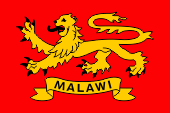
Flag of the President,
ratio = 2:3,
Source: Flags of the World




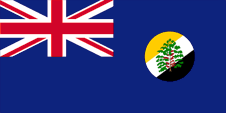
1893–1914,
British Central Africa Protectorate,
Flag of the government (state flag),
ratio = 1:2,
Source, by: Flags of the World



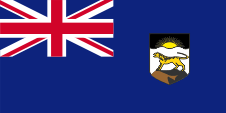
1914–1953,
Njassaland / Nyasaland,
Flag of the government (state flag),
ratio = 1:2,
Source, by: Flags of the World



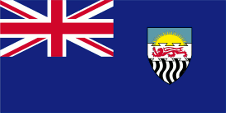
1953–1963,
Federation of Rhodesia and Nyasaland,
Flag of the government (state flag),
ratio = 1:2,
Source, by: Flags of the World



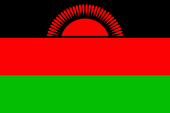
1964–2010,
National flag,
ratio = 2:3,
Source, by:
Corel Draw 4, Flags of the World





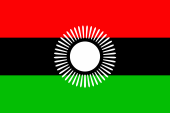
2010–2012 (Mathurika),
National flag,
ratio = 2:3,
Source, by:
Flags of the World






The on the occasion of the independence of Malawi on 6th of July in 1964 hoisted flag shows three horizontal stripes in black, red and green with a rising red sun in the black upper stripe. The sun has 31 rays, a hint for the fact, that Malawi became independent as the 31st state of Africa. The today's flag of Malawi was re-hoisted on 1st of June in 2012. It was already in use, from the 6th of July in 1964 to 31st of July in 2010. President Bingu wa Mathurika had in the meantime - and for no particular reason - introduced another flag, but this has found no acceptance among the population. When Mathurika died in April 2012, they saw no reason to use the "Mathurika Flag" linger, and they returned to the old flag from 1964 on 1st of June in 2012. The "Mathurika Flag" was based on the in 1964 on the occasion of Independence introduced flag and did show some changes, but the meaning of the colors and symbols have been retained. It showed three horizontal stripes in red, black and green and in the middle of the flag a white sun with 45 rays. Red stands for the blood shed for independence, black for the African continent, green for the forests and fields of Malawi. The sun symbolizes the hope for a new and successful development in Africa. It expresses the idea of "Kwacha", the dawn of a new era. With the exception of black, the colours of the Malawi flag have their difficulties. The colours are given in "British Standard Colours", which cannot easily be transferred to other colour systems. The colours of the flags on this page are therefore based on the colours of the flag used on the website of the UN Ambassador of Malawi. The today's national flag of Malawi is based on the flag of the Malawi Congress Party (MCP), which was since the achievement of the independence until 1994 the only party of the country. The party flag of the MCP has its roots in the by Marcus Garvey created black Liberation Flag and was introduced in 1953. The president's flag is red with a golden (British) lion, similar that in the middle part of the coat of arms. Below on a golden banner the name of the country: "MALAWI". The combination of the colours red, black and green is named Garvey-colours. They are those colours who created Markus Garvey in 1917 for the flag of the United Negro Improvement Association, which was striped in this colours. He was a supporter of the "Back-to-Africa"-Movement and saw in them the colours of a state for Blacks, which should be accomplished in Africa. But the colours get known in the USA and in the Caribic as the colours of the Black-Power-Movement, and get in Africa few persuasion. Nevertheless this colour-combination is sometimes named as Panafrican Colors.
Source:
Die Welt der Flaggen,
Flaggen Wappen Hymnen,
Flaggen-Atlas Erde,
Wikipedia (EN),
Flags of the World,
UNO,
www.touring-afrika.de

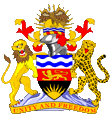
since 1964,
Coat of arms of Malawi,
Source:
Corel Draw 4

The coat of arms of Malawi was awarded by Queen Elisabeth II. on 30th of June in 1964. It shows on a shield the sun from the coat of arms of the former colony Njassaland, a lion as deputy of the fauna and of the former colonial might, and waves as symbol for the Malawi Sea. As shield supporters act a lion and a leopard. On the helmet – which crowns the coat of arms – an eagle as further deputy of the country's fauna. The shield rests on mountains, the Mlanje Massive. Below a banner with the motto of the country: "Unity and Freedom".
Source:
Die Welt der Flaggen,
Flaggen Wappen Hymnen,
Wikipedia (DE)

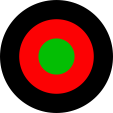
Aircraft Roundel,
Source, by: Wikipedia (EN)

Location:
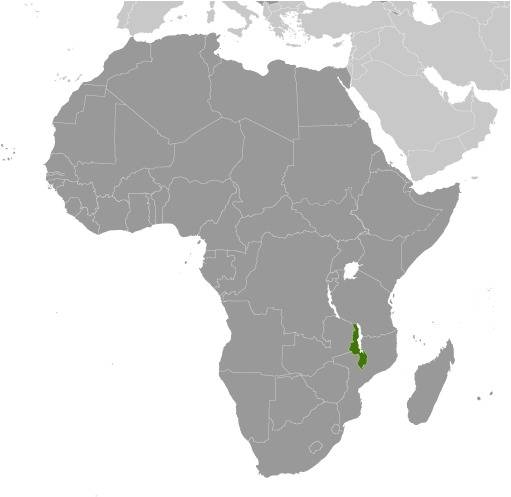
Source: CIA World Factbook
Map of the country:
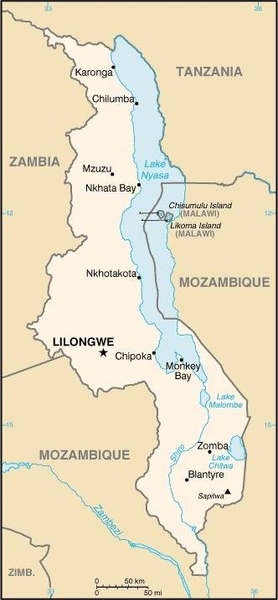
Source: CIA World Factbook

Area: 45.747 square miles
Inhabitants: 20.900.000 (2020), thereof 49% Maravi, 18% Lomwe, 13% Yao, 11% Ngoni
Religions: 83% Christian, 13% Muslim
Density of Population: 457 inh./sq.mi.
Capital: Lilongwe, 989.318 inh. (2018)
official Languagen: Chichewa, English
official Languagen: Chinyanja, Chiyao, Chitumbuka and further Bantu languages
Currency: 1 Malawi Kwacha (MWK, MK) = 100 Tambala
Time Zone: GMT + 2 h
Source:
Wikipedia (DE)

16th/17th century · Kingdom of Maravi
1875 · establishment of Scottish mission stations, beginning of the colonization by United Kingdom
1891 · establishment of the British protectorate (Nyasaland Districts)
1893 · rename in "British Central Africa Protectorate"
1907 · official introduction of the name Nyasaland
1953 · formation of the Central African Federation (Federation of Rhodesia and Nyasaland) together with Rhodesia (nowadays Zambia and Zimbabwe)
1963 · dissolution of the Central African Federation
1959 · anti-colonial riots, constitution
1962 · internal autonomy
6th of July 1964 · independence
1966 · rename in Malawi, proclamation of the republic, introduction of the single-party-system
1971 · presidial dictatorship
1992 · riots
1993 · after plebiscite introduction of the multi-party-system
Source:
Wikipedia (DE)

The name "Malawi" has its roots in the medieval "Kingdom of Maravi". The former name "Nyasaland" refers to the Yao word "nyasa", meaning "lake", what was the Lake Malawi / Lake Nyasa.
Source:
Volker Preuß,
Wikipedia (DE)


![]()


















![]()
